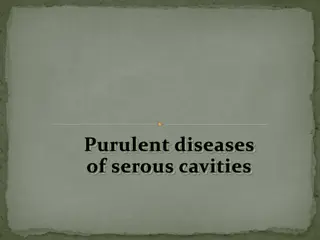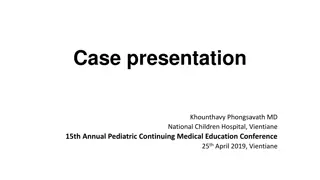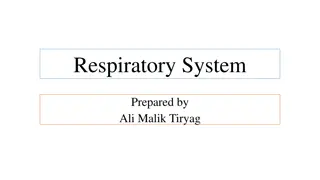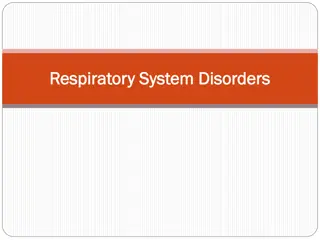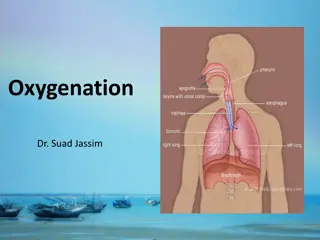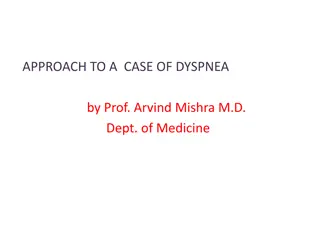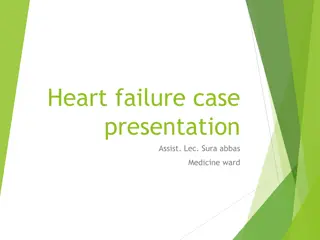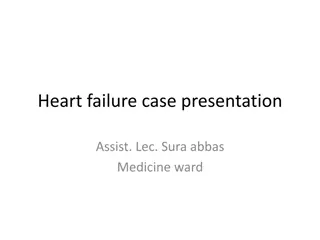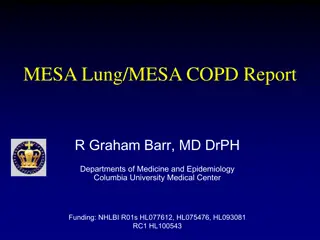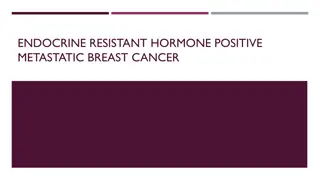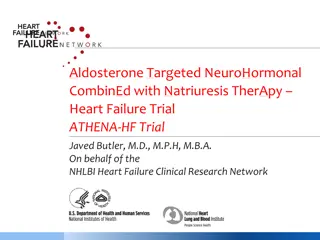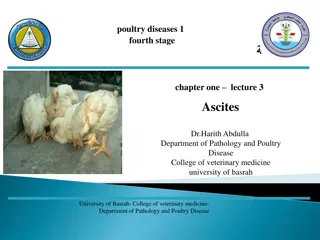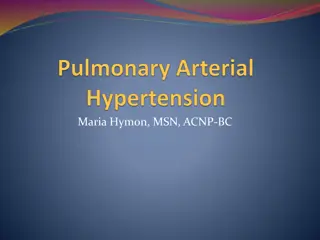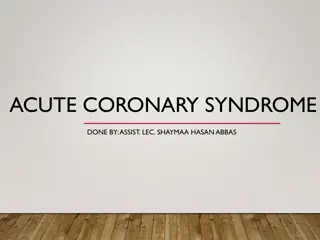Central America Hemoptysis Case Analysis
A 40-year-old male from Central America presented with 2-month hemoptysis history, dyspnea, chest pain, weight loss, and night sweats. Initial tests showed nodular opacities and cavitary lesions. Biopsy revealed Paracoccidioides infection treated with itraconazole. Clinical improvement noted.
0 views • 14 slides
Comprehensive Overview of Pulmonary Function Tests (PFTs)
Pulmonary Function Tests (PFTs) are vital for assessing pulmonary gas exchange through ventilation, diffusion, and lung perfusion. These tests include measurements of lung volume, airway patency, gas exchange efficacy, and pulmonary blood flow. PFTs offer benefits in diagnosing dyspnea, monitoring d
0 views • 14 slides
Purulent Diseases of Serous Cavities: Understanding Purulent Pleurisy and Empyema Pleurae
Purulent diseases of serous cavities, specifically purulent pleurisy and empyema pleurae, are marked by the secondary nature of inflammation in the parietal and visceral pleura. The classification details the etiology and clinical variations, while the pathogenesis explains the development from vari
0 views • 31 slides
Pediatric Case Presentation: Fever and Rash in a 3-Year-Old Patient
A 3-year-old female presented with fever, rash, cough, vomiting, diarrhea, and dyspnea. History revealed incomplete immunization and household fever cases. Physical exam showed tachycardia, respiratory distress, rash, and other symptoms. Past medical history indicated normal development and perinata
0 views • 26 slides
Understanding Dyspnea: Definition, Pathophysiology, and Causes
Dyspnea, or breathing discomfort, is a complex symptom with varying intensities and causes, including lung diseases, cardiac issues, anemia, obesity, and deconditioning. This article explores the definition, pathophysiology, and different approaches to understanding and managing dyspnea, highlightin
0 views • 28 slides
Understanding the Respiratory System: An Overview
The respiratory system, consisting of the upper and lower respiratory tracts, is responsible for ventilation and gas exchange. Learn about the anatomy, common symptoms like dyspnea and cough, and how the system functions anatomically and physiologically. Understanding these aspects can help in recog
0 views • 15 slides
Understanding Respiratory System Disorders and Functions
Explore the anatomical structure, functions, and symptomatology of respiratory system disorders. Learn about dyspnea, hemoptysis, hypoxemia, orthopnea, and more. Understand asthma pathophysiology, pneumonia factors, and nursing care for asthmatic patients.
0 views • 20 slides
Understanding Oxygenation and Respiratory System Function
Explore essential terms like alveoli, perfusion, atelectasis, and more in the context of respiratory system function. Learn about lung anatomy, oxygenation processes, and common respiratory disorders like dyspnea and hypoxia. Discover the crucial factors for maintaining normal respiratory function.
0 views • 35 slides
Complex Case Study: CABG Surgery with Complications and Challenges
A 35-year-old male autodriver presented with dyspnea, chest pain, and a history of alcohol addiction. Past procedures included PTCA with stent in the LAD. Diagnostic tests revealed severe cardiac issues leading to CABG surgery with a twist involving pericardial adhesiolysis and cardiopulmonary bypas
0 views • 19 slides
Understanding Hypertrophic Cardiomyopathy (HCM) in a Middle-Aged Female with Heart Failure
A 55-year-old female with a history of hypertension and heart failure presented with symptoms of dyspnea, chest pain, and a positive family history of cardiac disease. Exam findings included LVH on ECG and a systolic murmur at LLSB. This case highlights the importance of recognizing and managing hyp
0 views • 20 slides
Understanding Dyspnea: Causes and Approach by Prof. Arvind Mishra, M.D.
Dyspnea, defined as breathing discomfort, can stem from respiratory or cardiovascular issues. Respiratory causes include airway diseases like asthma, pleural and lung diseases, and chest wall disorders. Meanwhile, cardiovascular causes involve left heart diseases, pulmonary vasculature issues, and p
2 views • 34 slides
Comprehensive Heart Failure Case Presentation: Diagnosis and Treatment Plan
A 68-year-old man with a history of CAD and diabetes presents with symptoms of heart failure, including dyspnea and fluid retention. His medical history, physical exam, and diagnostic tests reveal signs consistent with heart failure. Further evaluation and treatment planning are necessary to manage
0 views • 28 slides
Comprehensive Evaluation of Heart Failure in a 68-Year-Old Man with Co-Morbidities
A 68-year-old man with a history of CAD, type 2 diabetes, and other comorbidities presents with symptoms suggestive of heart failure. His chief complaints include dyspnea, orthopnea, lower extremity edema, and decreased exercise tolerance. Through medical history, physical examination, and diagnosti
0 views • 12 slides
Overview of Emphysema and COPD Research Studies
Research conducted by Dr. R. Graham Barr and his team at Columbia University Medical Center focuses on emphysema and COPD, funded by NHLBI grants. The studies explore the genetic basis, prevalence in the general population, and impact on lung function and mortality. Various imaging techniques and ge
0 views • 25 slides
Metastatic Breast Cancer Treatment and Progression Overview
Mrs. GV, a 78-year-old woman with endocrine-resistant hormone-positive metastatic breast cancer, presented with dyspnea. Her medical history includes chronic fatigue syndrome, hypothyroidism, and hypertension. Disease progression led to dermal and intraocular metastasis, managed with treatments like
0 views • 16 slides
Study on High-Dose Spironolactone in Acute Heart Failure Patients
The ATHENA-HF trial investigates the impact of high-dose spironolactone on reducing NT-proBNP levels in acute heart failure patients. Key objectives include assessing congestion, dyspnea relief, urine output, weight change, diuretic requirement, and outcomes like mortality and readmissions up to 60
0 views • 20 slides
Ascites in Broiler Chickens: Causes, Symptoms, and Management
Ascites is a common disease in broiler chickens, especially at high altitudes. It is characterized by fluid accumulation in the peritoneal cavity or pericardial sac, often containing yellow protein clots. Predisposing factors include reduced ventilation, high altitude, and respiratory disease. Sympt
0 views • 13 slides
Understanding Pulmonary Arterial Hypertension (PAH): Causes, Symptoms, and Management
Pulmonary Arterial Hypertension (PAH) is a progressive disease characterized by increased blood pressure in the pulmonary artery, veins, or capillaries. This condition can lead to right ventricular failure and eventual death if left untreated. PAH can have various causes, including idiopathic factor
0 views • 49 slides
Managing Respiratory Distress in End-of-Life Care
Respiratory distress is a common issue in end-of-life care, often causing significant distress to patients and their families. Understanding the causes, utilizing opioids for dyspnea management, implementing non-pharmacological measures, and knowing when to use a distress protocol are crucial in pro
0 views • 26 slides
Understanding the Respiratory System: An Overview
The respiratory system comprises the upper and lower respiratory tracts, responsible for air movement and gas exchange. It relies on the cardiovascular system for proper blood flow. The anatomy involves structures in the upper and lower tracts, with common symptoms like dyspnea and cough indicating
0 views • 20 slides
Understanding Acute Coronary Syndrome: Diagnosis and Immediate Therapies
A 58-year-old man presents with acute severe chest pain, diaphoresis, dyspnea, and risk factors for coronary heart disease. The most likely diagnosis is acute myocardial infarction. Immediate steps include placing the patient on a cardiac monitor, obtaining an ECG, and administering aspirin. Additio
0 views • 19 slides


